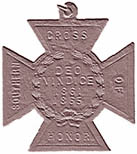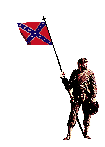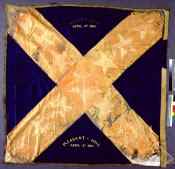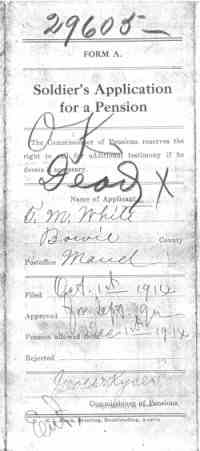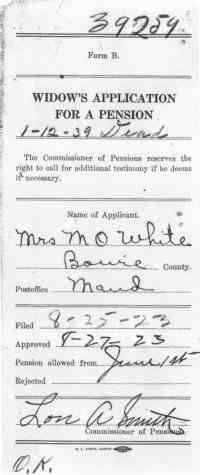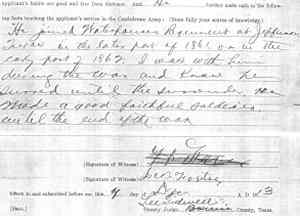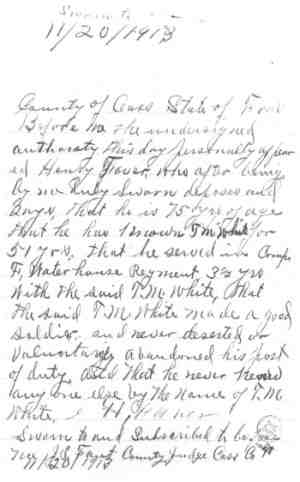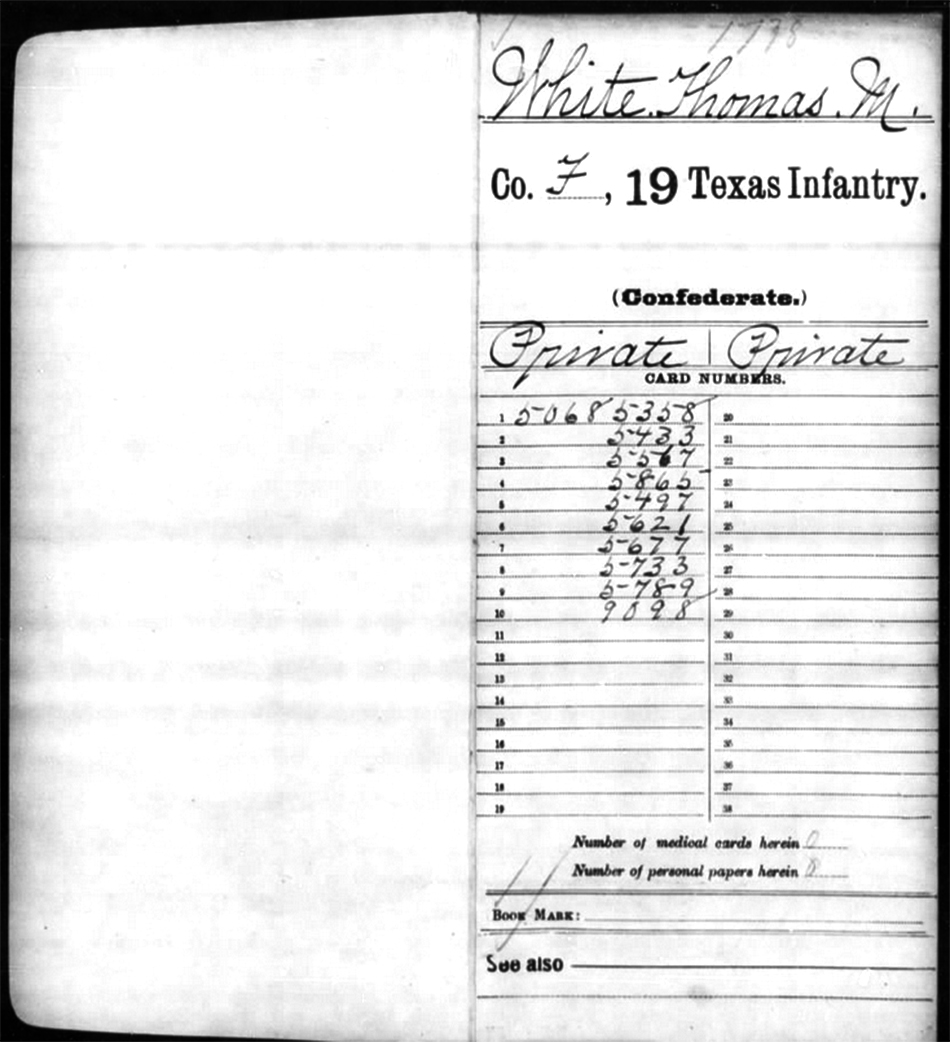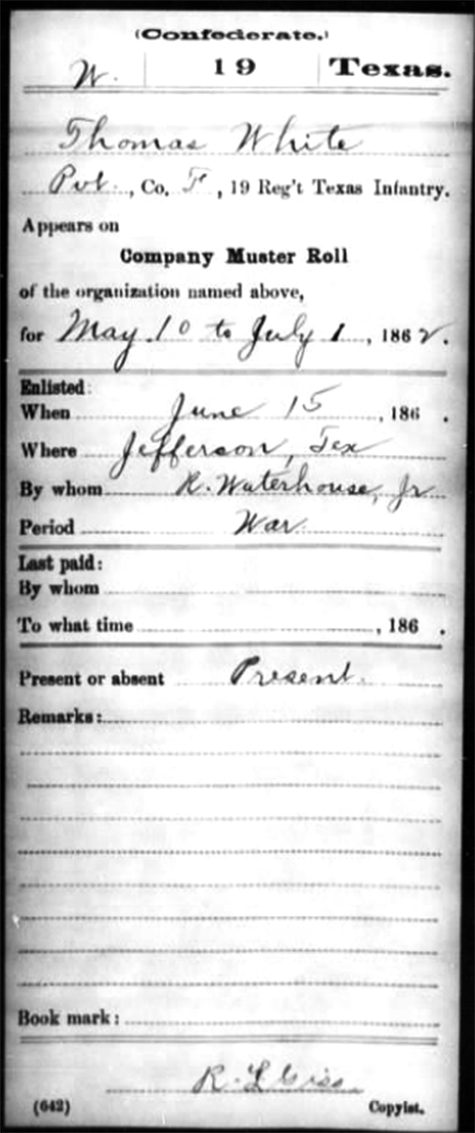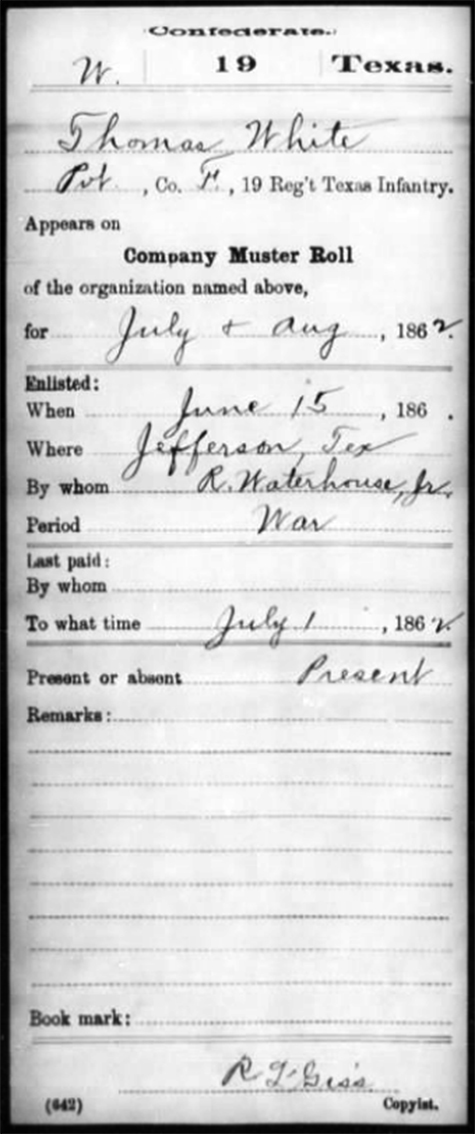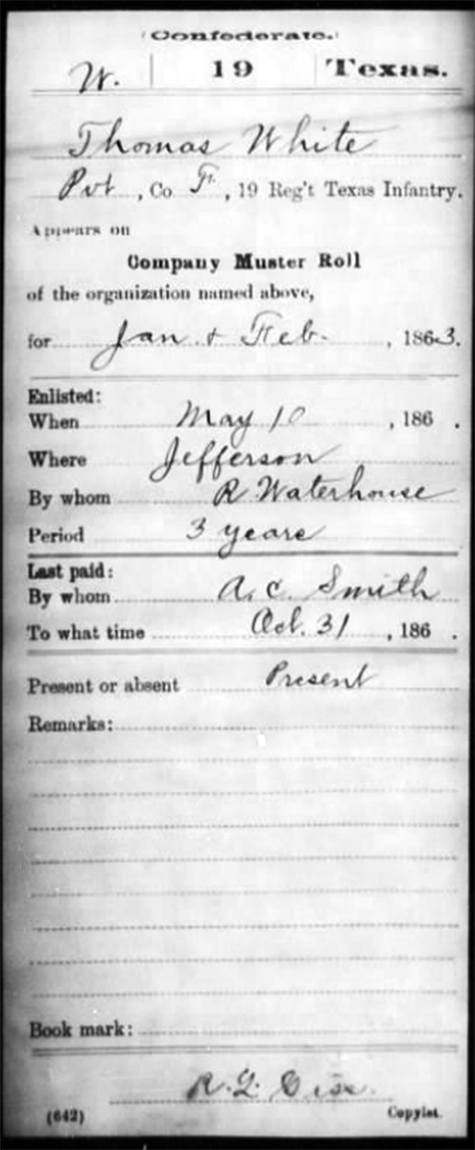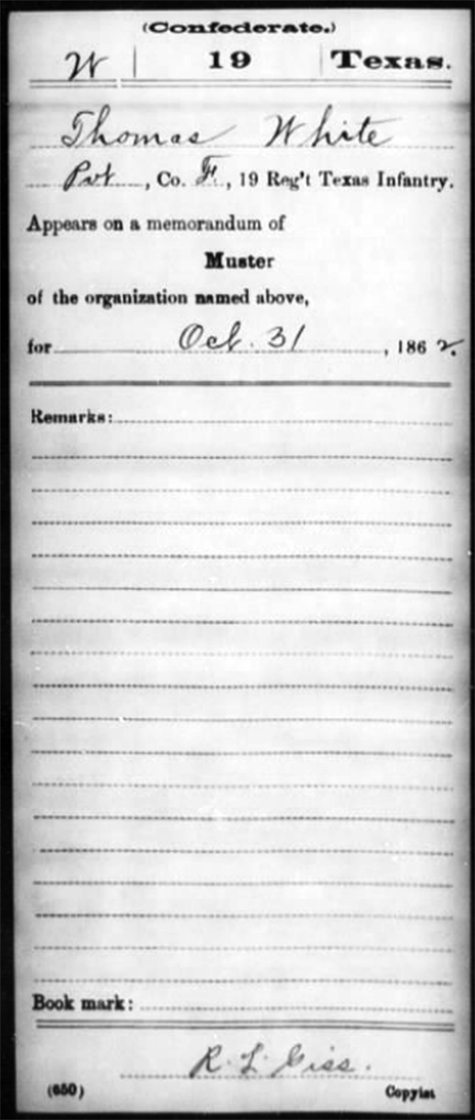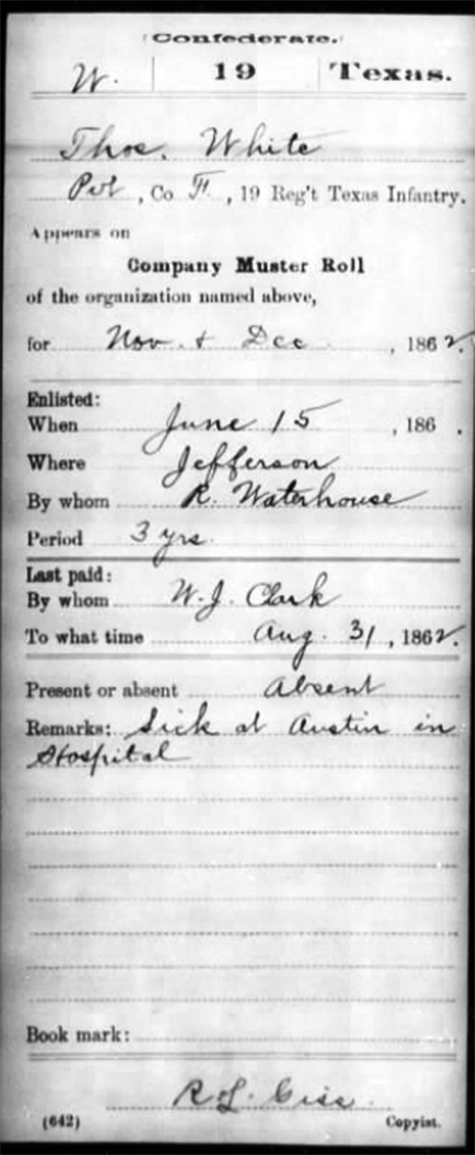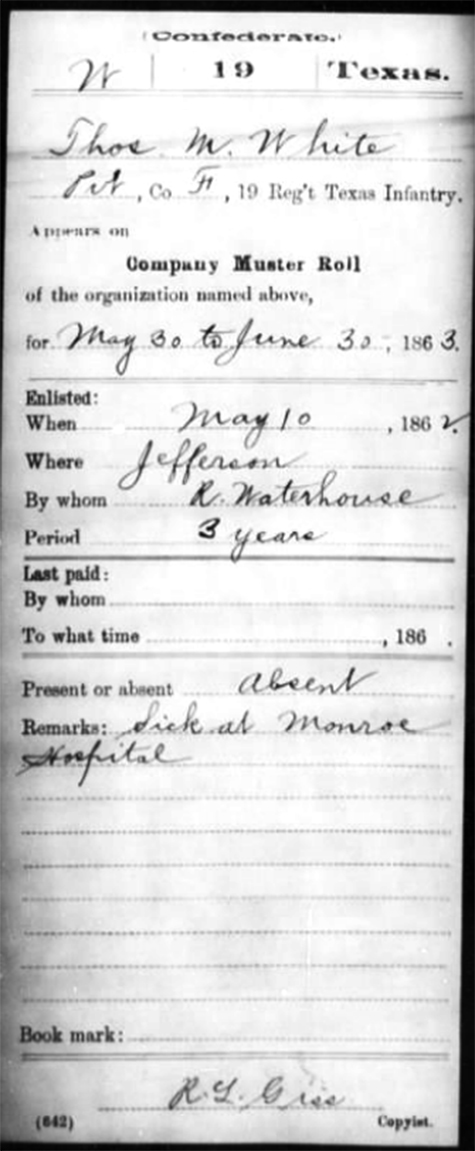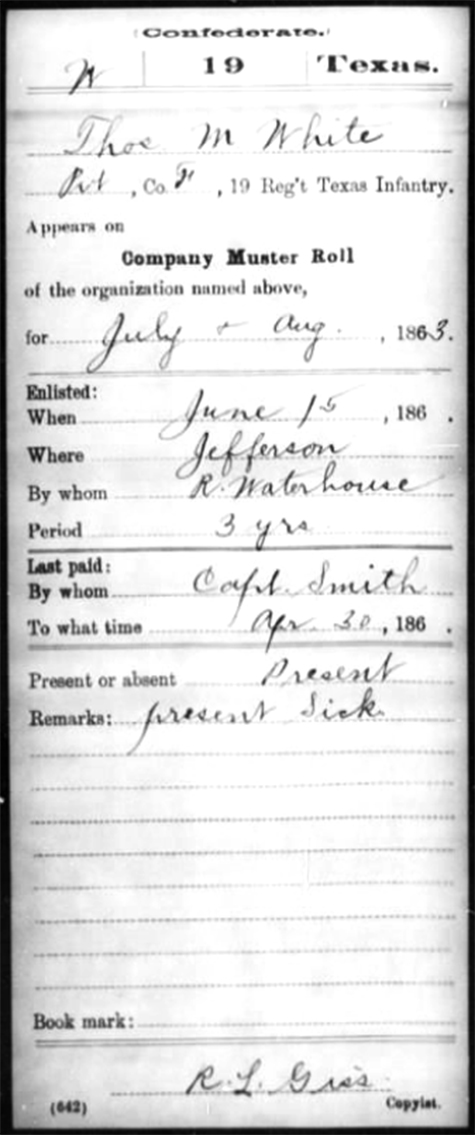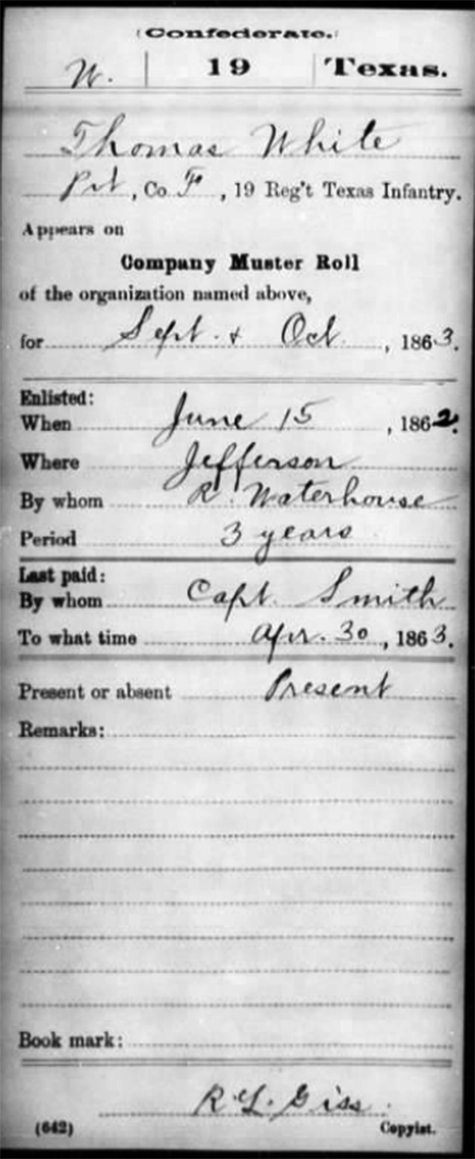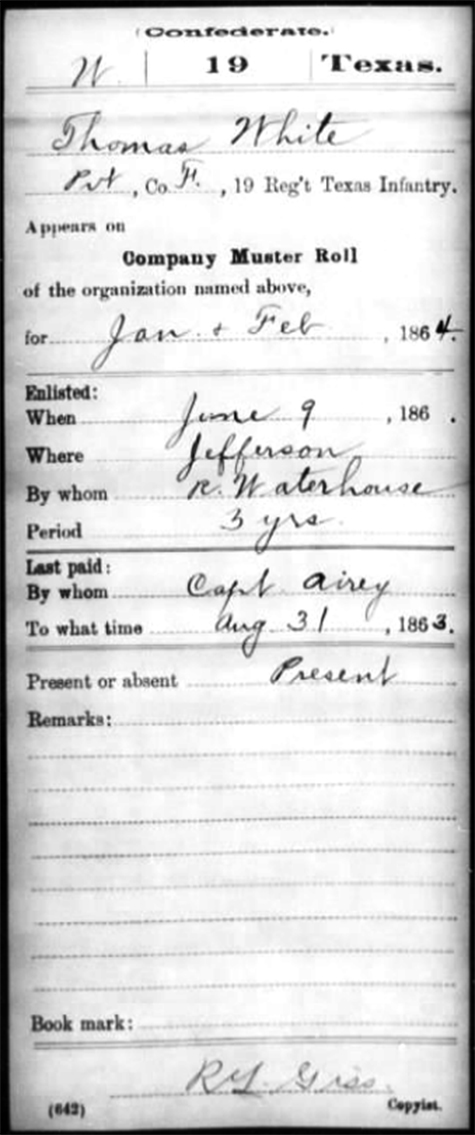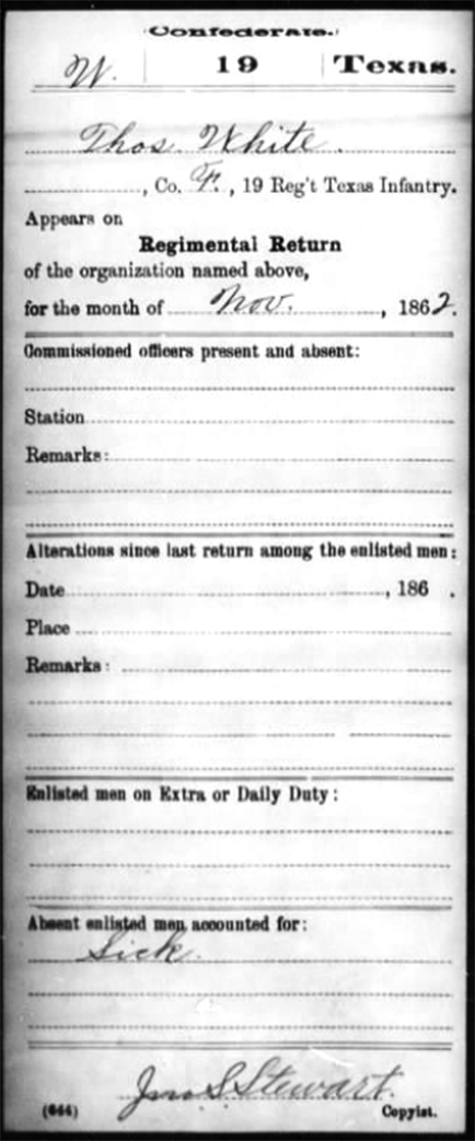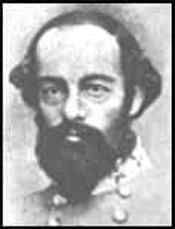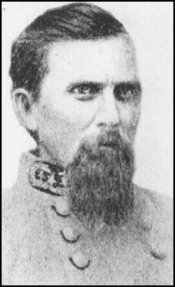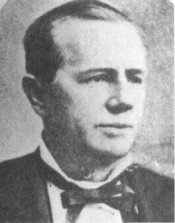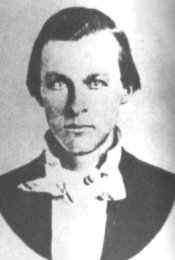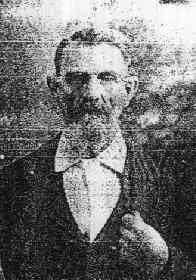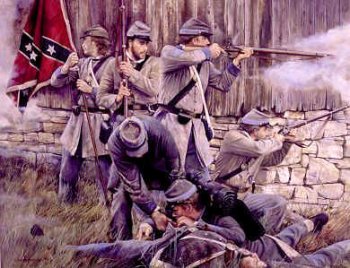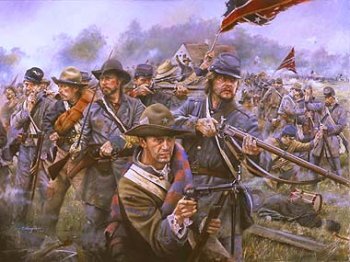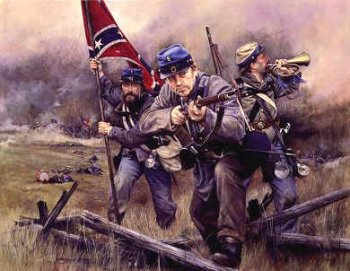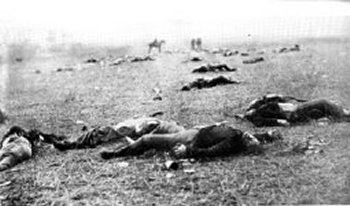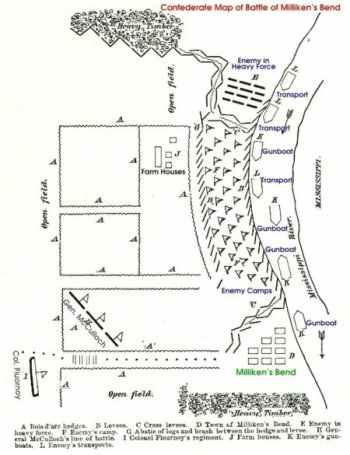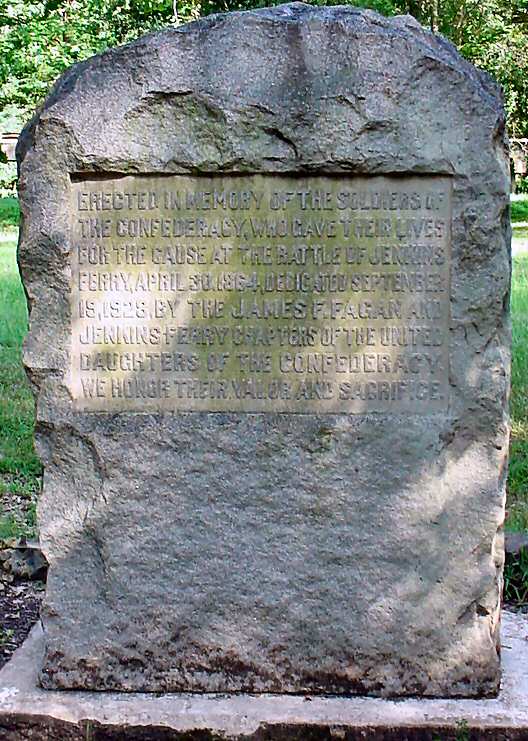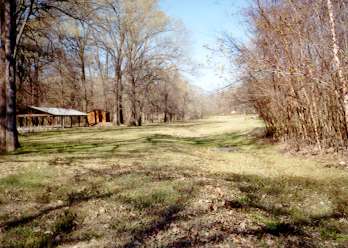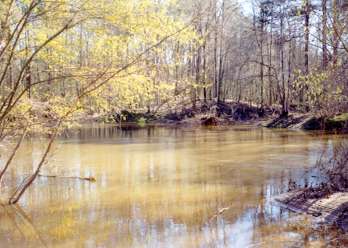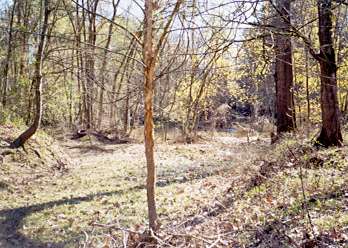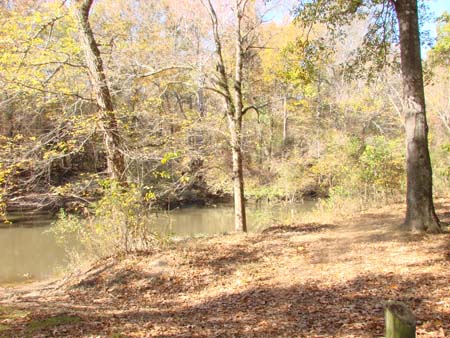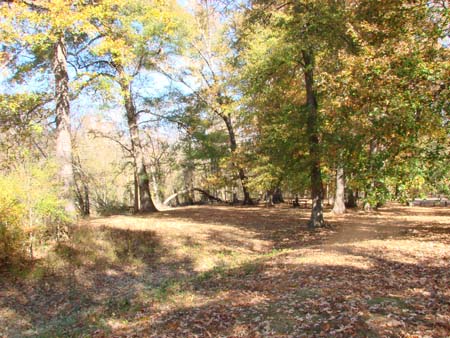|
June 7, 1863
...The Confederate plan of action called for a night march.
The Texans left Richmond at 6:00 p.m., on June 6, in hopes of arriving at
the enemy camps at sunrise. One Texan recorded the march with these words:
In sections four abreast, and close order, the troops
took up the line of march, in anticipation of meeting almost certain
death, but with undaunted, unquailing spirits. In breathless silence,
with the high glittering stars looking down upon them, through dark and
deep defiles marched the dense array of men, moving steadily forward;
not a whisper was heard--no sound of clanking saber, or rattle of
canteen and cup.
At Oak Grove plantation the road forked, the left fork led
to Milliken's Bend, the right to Young's Point. Walker sent McCulloch's
Brigade toward Milliken's Bend and Hawes' Brigade toward Young's Point,
while he remained at Oak Grove with Col. Horace Randal's Brigade.
McCulloch's Brigade, 1,500--strong, arrived within one and
one-half miles of Milliken's Bend at 2:30 a.m. when it was fired upon by
enemy pickets. McCulloch quickly deployed his brigade into line of battle
with Col. Richard Waterhouse's* 19th Texas Infantry on
the right, Col. R. T. P. Allen's 17th Texas Infantry in the center, and Lt.
Col. E. P. Gregg's 16th Texas Cavalry (dismounted) on the left. Col. George
Flournoy's 16th Texas Infantry was held in reserve.
*(Richard Waterhouse was the only colonel then
serving in the Texas Division who would rise up to be named a brigadier
general. Born in Rhea County, Tennessee, on January 12, 1832, he ran away
from home to serve in the Mexican War. At the outbreak of the Civil War he
helped raise the 19th Texas and on May 13, 1862, was named colonel of the
regiment. He served in the Trans-Mississippi Department throughout the war
and saw action in both Arkansas and Louisiana. "Assigned to
command" as a brigadier general by Kirby Smith in 1864, Waterhouse was
not officially appointed by the president and confirmed by the Senate until
March 1865.)
Unable to cross the levee, McCulloch's men mopped-up
isolated pockets of resistance and plundered the Federal camp. The brigadier
sent an urgent request to Walker for reinforcements, but before help
arrived, McCulloch spotted a second gunboat, Lexington, coming
upriver. Realizing that his troops were no match for gunboats, and without
waiting for Walker's arrival, McCulloch ordered a withdrawal to Oak Grove
plantation.
In the engagement at Milliken's Bend, McCulloch's Brigade
suffered losses of 44 killed, 131 wounded, and 10 missing. The Texans,
however, inflicted 652 casualties on the Federals of which number 101 were
killed, 285 wounded, and 266 captured or missing.
Confederate
Map of Battle of Milliken's Bend
The
War of the Rebellion:
a Compilation of the Official
Records of the Confederate
Armies Chapter XXXVI - 1880
CONFEDERATE REPORT:
Battle of Milliken's Bend
Actual
Battle Report - Brig. Gen. McCulloch June 8, 1863
SERIES
I PART II VOL 24 CHAP. XXXVI OPERATIONS IN NORTHERN LOUISIANA.
Pp. 467-470
Report
of Brig. Gen. Henry E McCulloch, C. S. Army, commanding Brigade, of attack
(7th) on Milliken's Bend.
HEADQUARTERS
McCULLOCH'S BRIGADE,
Richmond,
La., June 8, 1863.
According
to orders, on the night of the 6th my brigade took up the line of march for
Milliken's Bend, to attack the Yankee force at that place.
We
advanced to within about 1 1/2 miles at 2.30 a.m. on the 7th instant, when
the enemy's pickets fired upon my cavalry scouts and skirmishers. The
cavalry scouts fell back precipitately upon the skirmishers, amid the fire
of the enemy, which led the skirmishers to suppose them a portion of the
enemy's cavalry; consequently they fired upon them, killing two of their
horses and wounding a third. Fortunately no man was killed or wounded by
this fire. My skirmishers immediately pressed forward, driving the pickets
of the enemy before them. We advanced but a quarter of mile farther when the
enemy's skirmishers in considerable force opened upon us under cover of a
thick hedge. A portion of the command was immediately thrown in line, moved
forward, and drove the enemy from his lurking place to the next hedge, about
600 yards farther; and thus the fight or skirmishing continued from hedge to
hedge and ditch to ditch, until within 215 paces of the main levee on the
bank of the Mississippi River, where the charge was ordered. Here we
encountered a thick hedge, which could not be passed except through a few
gaps or breaches that had been made for gates and pass-ways. These had to be
passed by the troops the best they could, never fronting more than half a
company, before a line could be formed to charge the levee, which was the
breastwork of the enemy, 10 feet high, and in several places had a layer of
cotton bales on top, making a very formidable and secure work of defense.
The line was formed under a heavy fire from the enemy, and the troops
charged the breastworks, carrying it instantly, killing and wounding many of
the enemy by their deadly fire, as well as the bayonet. This charge was
resisted by the negro portion of the enemy's force with considerable
obstinacy, while the white or true Yankee portion ran like whipped curs
almost as soon as the charge was ordered. There were several instances in
this charge where the enemy crossed bayonets with us or were shot down at
the muzzle of the musket. No charge was ever more gallantly made than this,
and the enemy were not only driven from the levee, but were followed into
their camp, where many of them were killed.
In
this charge Colonel [Richard] Waterhouse with his regiment
distinguished themselves particularly, not only by a gallant and desperate
charge over the levee, but they drove the enemy (leaving the camp covered
with the dead) to the very bank of the river, and within short and direct
range of the gunboats of the enemy. In fact, from the beginning to the end
of the engagement, the colonel behaved in the most gallant manner, and his
officers and men seemed to catch the enthusiasm of their commander, and did
their duty nobly and gallantly upon every portion of the field
Colonel
[R. T. P.] Allen's regiment was immediately on the left of Colonel
Waterhouse, and Colonel [William] Fitzhugh's regiment (under the command
of Lieutenant Colonel [E. P.] Gregg) was immediately on the left of Colonel
Allen. Both of these regiments, officers and men, conducted themselves in
the most praiseworthy and gallant manner, advancing coolly and steadily,
forming and charging in the most gallant style under a heavy and destructive
fire of the enemy, during all of which the officers distinguished themselves
for coolness and courage, and their men for a determination to conquer or
die.
Colonel
Allen was slightly wounded, but never left his post. Lieut. Col. Gregg and
Major [W. W.] Diamond, of Colonel Fitzhugh's regiment, were both wounded too
badly to admit of their remaining in command, which left the regiment
without a field officer, but did not destroy their usefulness or dampen
their ardor; upon the contrary, seemed to make them fight the more fiercely;
and under the command of Captain [J. D.] Woods (senior captain) and their
respective company commanders, they continued to fight steadily on until the
close of the action.
Colonel
[George] Flournoy's regiment was not in the principal charge upon the
enemy's works, but performed good service afterward, assisted by small
portions of the other three regiments, in driving the enemy from an angle in
the levee, and log and brush barricade which commanded a considerable
portion of our line, and from which they were pouring a heavy fire upon us.
This position was of too much importance to the enemy to be given up without
a desperate struggle, while we were suffering too much by its occupation by
them to allow its continuance; hence they were driven from it by assault
with considerable slaughter. During the balance of the day this important
point was held by Colonel Flournoy's regiment, and although they were
more exposed to the fire of the gunboats than any other portion of my
command, the regiment behaved itself well and sustained its character for
courage and gallantry.
Major
[R. D.] Allen, of Colonel Allen's regiment, was placed in command of the
skirmishers during the advance, and as his command and that of Colonel
Flournoy was not under my immediate observation during the whole
engagement, I have called upon them for official reports, which I
respectfully forward, and to which beg leave, respectfully to call the
attention of the major-general commanding.
There
were too many instances of individual coolness, courage, and gallantry to
mention in this report; but the services of Captain [G. T.] Marold, of Colonel
Flournoy's regiment, and Private [A.] Shultz, of the band, of the same
regiment, deserve notice. During the engagement some fears were entertained
by a portion of the officers of the command that the enemy would or were
attempting to turn our left flank. To quiet this apprehension and drive some
negroes from some houses from which they occasionally fired a shot at us,
Captain Marold was sent out with his company and captured 19 negroes, all of
which were at or in the vicinity of the houses from which we had been
several times fired at by negroes. Some of them fired at officers of my
staff while making reconnaissance of ditches, hedges, and fields in and
about our battlefield. These negroes had doubtless been in the possession of
the enemy, and would have been a clear loss to their owners but for Captain
Marold; and should they be forfeited to the Confederate States or returned
to their owners, I would regard it nothing but fair to give to Captain
Marold one or two of the best of them.
Mr.
[A.] Shultz being on duty with the surgeon's infirmary corps, he was sent
with Dr. Cocke's horse to a house for some cistern water for the wounded.
When he arrived at the house, he found himself surrounded by a company of
armed negroes in full United States uniform, commanded by a Yankee captain,
who took him prisoner. The captain asked him where the main body of our
troops were. He pointed at once to the southwest, in an entirely different
direction from where we were then engaged with the enemy. The captain then
observed that, only a portion of our command being present, it might be
possible for him to get through our lines to the transports. Shultz told him
he could easily do so, and proffered to show him the way to avoid us. The
Yankee suffered himself to be humbugged by our German youth, or young man,
and he led him and his entire company of 49 negroes through small gaps in
thick hedges until they found themselves within 60 yards of Colonel Allen's
regiment, who took them all prisoners without the fire of a gun. Thus by his
shrewdness the young Dutchman released himself and threw into our hands 1
Yankee captain and 49 negroes, fully armed and equipped as soldiers, and, if
such things are admissible, I think he should have a choice boy from among
these fellows to cook and wash for him and his mess during the war, and to
work for him as long as the negro lives. And as the horse of Dr. Cocke was
lost in the praiseworthy effort to procure water for our wounded, another of
these fellows might be well and properly turned over to him to compensate
him for his loss.
My
loss in this engagement was 44 killed, 130 wounded, and 10 missing. Several
of the wounds are mortal, and many others so serious as to render recovery
doubtful, while in proportion to the number more are severe and fewer slight
than I have ever witnessed among the same number in my former military
experience. This makes my casualties 184, embracing 2 officers killed, viz,
Lieut. Thomas Beaver, of Colonel Allen's regiment, and Lieut. B. W. Hampton,
of Colonel Fitzhugh's regiment, and 10 wounded, viz, Colonel Allen,
Lieutenant-Colonel Gregg, Major Diamond, Captains [E. P.] Petty, [S. J. P.]
McDowell, and [J. H.] Tolbert, Lieutenants (T. H.] Batsell, [D. M.] Waddill,
[G. A.] Dickerman, and [James M.] Tucker, which is an exceedingly heavy
loss, but nothing to compare with that of the enemy. It is true that no
certain or satisfactory estimate could be made of the loss of the enemy, but
I know, from the dead and wounded that I saw scattered over the field in the
rear of the levee, and those upon and immediately behind it, it must have
been over a thousand.
My
full strength on the battle-field did not exceed 1,500 men, while that of
the enemy must have been over twice, if not three times, that number, backed
by three gunboats that were kept constantly playing shot and shell upon us
during the whole engagement.
The
attack was made under verbal orders from Major-General Taylor "to
engage the enemy before day and carry his works at the point of the
bayonet," which orders were doubtless based upon information received
which led him to believe that there was only one battalion of Yankee cavalry
and one of negro infantry at the camp, without any batteries of field
artillery or gunboats, while I have no doubt that the enemy were fully
apprised of our approach, had made full preparations to receive us, and had
received a re-enforcement of three transport loads of troops during the
night before. I was entirely misinformed by our guide with regard to the
ground over which we had to advance. Instead of finding it a smooth, open
field without obstructions, I found the ground exceedingly rough, covered
with small running briars and tie vines, through which infantry could
scarcely march, and so much cut up with ditches and obstructed with hedges
that it was impracticable to make any well-regulated military movement upon
it; and; under all the circumstances, I would not have been the least
surprised if we had made an entire failure; and nothing but the best and
bravest fighting, under the providence of God, could have crowned our
efforts with even partial success.
During
this engagement the officers and men of my command behaved most gallantly,
deserving the gratitude of the country and highest commendation of their
commanders; and I am perfectly satisfied that there is not a troop in the
Confederate States of the same number that could have done better fighting
under the same circumstances.
During
the day's fighting Captain [Benjamin E.] Benton, assistant adjutant-
general, and Major [J. H.] Earle, brigade commissary and acting
aide-de-camp, and Maj. W. G. King, brigade quartermaster, of my regular
staff, rendered me great service; and Capt. W. D. Mitchell, forage master,
who acted as volunteer aide-de-camp, also, who bore frequent and important
messages for me during the day to different portions of the field,
frequently under heavy fire. Captain Benton and Major Earle were about my
person except when absent under orders, and were exposed to the fire of the
enemy from beginning to the close of the battle. Both of these officers
acted with great gallantry throughout the day. Captain Benton participated
in every forward movement and charge, moving amid the troops on horseback,
constantly urging them on to the enemy.
Great
credit is due the surgical corps of the brigade and Surgeon [E.J.] Beall, of
the division, for efficient services to the wounded; especially to Dr.
[William P.] Head, of Colonel Fitzhugh's regiment, and Dr. [William J.]
Cocke, of Colonel Flournoy's regiment, who were not only the most active and
energetic in their attentions to and operations on the wounded, but went
upon the field at the beginning of the fight, and organized their respective
corps and put them in operation. My thanks are tendered to the medical
officers of Colonel Randal's brigade for the kind and efficient services
rendered my suffering companions in arms on the day of the battle.
Accompanying
this report will be found a complete list of the killed, wounded, and
missing, made from the reports of regimental commanders. My loss is truly
deplorable, and my very heart sickens at its contemplation. But the scathing
ordeal through which my little brigade was compelled to pass has increased
my confidence in and love for them, and makes me anxious to see them have at
least one fair chance to meet the enemy where they can gain a complete
victory to compensate them for the gallant fighting they have done and
always will do when called upon to meet the foe.
Most
respectfully, your obedient servant,
H.
E. McCULLOCH,
Brigadier- General, Commanding Brigade.
Maj. R. P. MACLAY, Assistant Adjutant and Inspector General.
Confederate
Casualties in McCulloch's Brigade
in the engagement at Milliken's Bend, June 7, 1863
Killed.
Wounded
Missing.
officers
Men
Officers
Men
Officers
Men
Total
16th
Texas
2
5
7
17 t h Texas
1
20
4
61
3
92
19th Texas Infantry
2
11
6
19
16th Texas Cavalry
1
18
6
41
1
67
Total
2
42
10
121
1
9
185
*Lieut.
Thomas Beaver killed.
**Lieut. B. W. Hampton killed.
|
 In Honor of our Great
Grandfather
In Honor of our Great
Grandfather 

